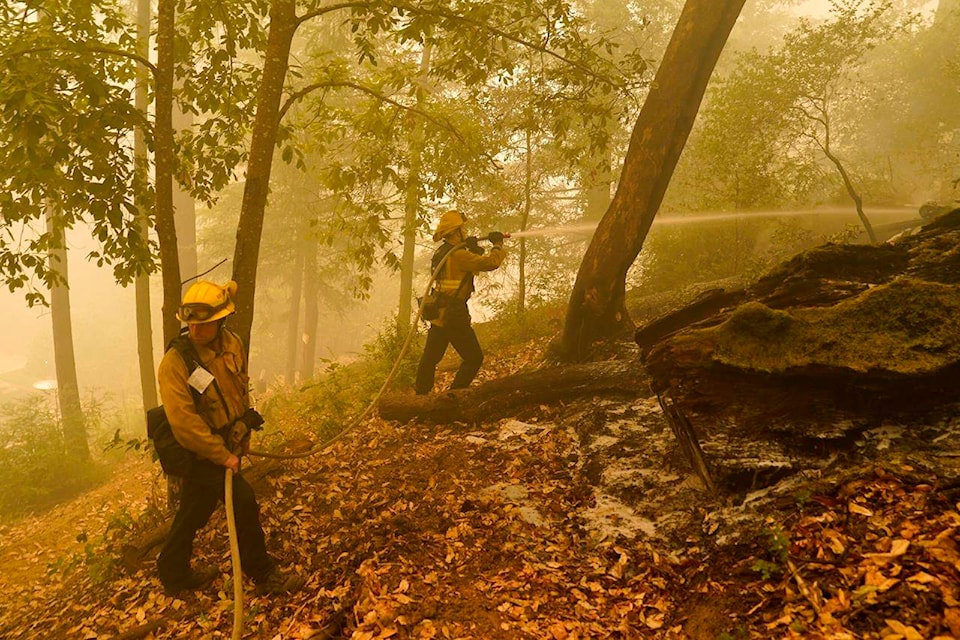SAN FRANCISCO — A calm overnight allowed firefighters to make progress against a trio of massive wildfires burning in Northern California but they were girding for a weather system Sunday that will bring high winds and thunderstorms that could spark new fires and fan existing blazes that destroyed nearly 1,000 homes and other structures and forced tens of thousands to evacuate.
The “complexes,” or groups of fires, burning on all sides of the San Francisco Bay Area were started by lightning strikes that were among 12,000 registered in the state in the past week. The National Weather Service issued a “red flag” warning through Monday afternoon for the drought-stricken area, meaning extreme fire conditions including high temperatures, low humidity and wind gusts up to 65 mph (105 kph) that “may result in dangerous and unpredictable fire behaviour.”
At a morning briefing on the so-called CZU Lightning Complex fire in the Santa Cruz Mountains south of San Francisco fire officials said they had increased containment to 8% and with the better weather on Saturday dug more protective fire lines around vulnerable communities, including the University of California, Santa Cruz.
But there is concern about the weather and the thunderstorms that will bring high winds and “dry” lightning, a term used when such storms have little or no rain.
Chief Mark Brunton, a battalion chief for the California Department of Forestry and Fire Protection (Cal Fire), said the winds can blow a fire in any direction and while he’s confident firefighters did the most with the time they had to prepare, he’s not sure what to expect.
“There’s a lot of potential for things to really go crazy out there,” he said.
Another challenge for firefighters and police are people who refuse to leave the evacuation zone out of stubbornness or because they want to protect their homes and others who use the chaos to commit crimes. Brunton said he was “sickened” to learn that a fire commander was robbed while helping co-ordinate efforts on Saturday. Someone entered the commander’s fire vehicle and stole personal items, including a wallet and “drained his bank account.”
Santa Cruz Sheriff’s Department Chief Deputy Chris Clark said when people don’t heed evacuation orders it makes it harder for firefighters to do their job and for police to protect property. It’s also inherently dangerous for civilians, with fires burning unpredictably and tree branches falling — one hit a patrol car and damaged the windshield.
“Please, please, please leave the evacuation area,” he said.
Since Aug. 15, state fire officials said more than 500 fires of varying sizes have burned throughout California, scorching a million acres, or 1,562 square miles (4,046 square kilometres). Of those, about two dozen major fires were attracting much of the state’s resources.
Most of the damage was caused by the three complexes that were ravaging forest and rural areas in and around the San Francisco Bay Area. They have burned 1,175 square miles (3.043 square kilometres), destroyed almost 1,000 homes and other structures and killed five people, three of them who were found in a home in an area under an evacuation order.
Other casualties included ancient redwood trees at California’s oldest state park, Big Basin Redwoods, plus the park’s headquarters and campgrounds. Smoke from the fires made the region’s air quality dangerous, forcing millions to stay inside.
“Tuesday night when I went to bed I had a beautiful home on a beautiful ranch,” said 81-year-old Hank Hanson of Vacaville. “By Wednesday night, I have nothing but a bunch of ashes.”
The fire that burned Hanson’s home is the LNU Lightning Complex fire in wine country north of San Francisco. It’s been the most destructive, accounting for all the deaths and 845 destroyed homes and other buildings. It and a fire burning southeast of the Bay Area are among the five largest fires in state history, with both burning more than 500 square miles (1,295 square kilometres)
Responding to the emergency, President Donald Trump on Saturday issued a major disaster declaration to provide federal assistance. Gov. Gavin Newsom said in a statement that the declaration will also help people in counties affected by the fires with crisis counselling, housing and other social services.
Fire officials, meanwhile, have struggled to get enough resources to fight the biggest fires because so many blazes are burning around the state.
The wine country fire has only 1,700 firefighters on scene. By comparison, the state had 5,000 firefighters assigned to the Mendocino Complex Fire in 2018, the largest fire in state history.
“All of our resources remain stretched to capacity that we have not seen in recent history,” said Shana Jones, the chief for Cal Fire’s Sonoma-Lake-Napa unit.
Underscoring the danger the fires pose for firefighters, the Sonoma County sheriff’s office released dramatic video of the helicopter rescue Friday night of two firefighters trapped on a ridge line at Point Reyes National Seashore. They were hoisted to safety as flames advanced.
“Had it not been for that helicopter, those firefighters would certainly have perished,” Sonoma County Sheriff Mark Essick said.
___
Baker reported from Los Angeles. Associated Press writers Martha Mendoza contributed from Scotts Valley, California, and Adam Beam from Sacramento.
Daisy Nguyen And Frank Baker, The Associated Press
